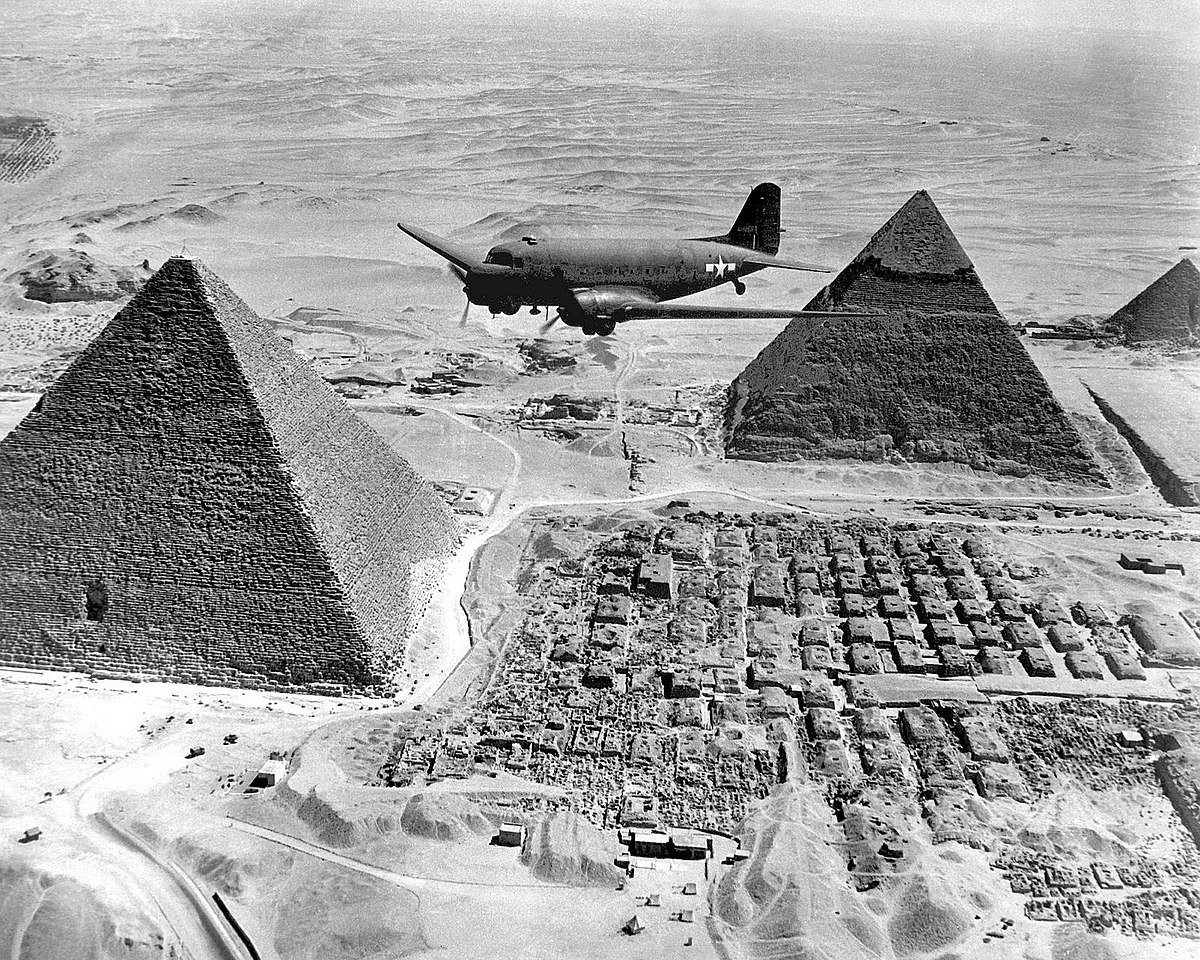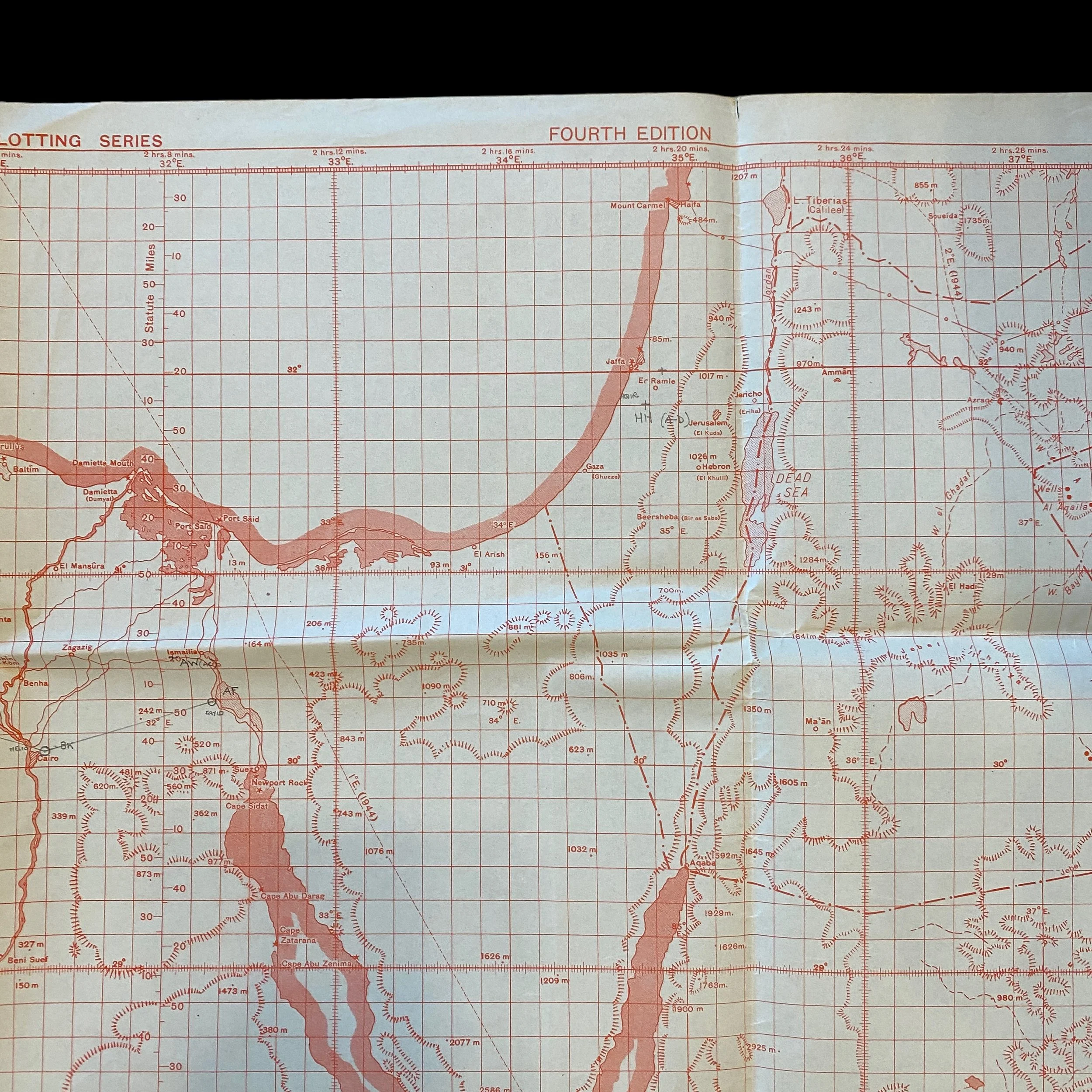RARE! 1944 Allied Air Operations Egypt & Cairo Mediterranean and Middle East Theater Plotting Series (Mission Marked)























RARE! 1944 Allied Air Operations Egypt & Cairo Mediterranean and Middle East Theater Plotting Series (Mission Marked)
Comes with C.O.A.
This incredibly rare and museum-grade World War II April 1944 dated Plotting Series map was used by the Allied navigators while operating in the Mediterranean and Middle East Theater during WWII. This Allied navigator’s map shows incredible mission marks and navigational flight lines around Cairo and Ismailia.
Plotting Series Maps During WWII:
During World War II, the Allied forces faced numerous challenges in their quest to achieve air superiority and disrupt enemy operations through strategic bombing raids. The success of these missions hinged not only on the bravery and skill of the aircrews but also on the availability of accurate navigational tools. The development and utilization of Allied Plotting Series air maps played a pivotal role in these operations. These maps, created with unprecedented precision and detail, proved to be indispensable tools for navigators and bombardiers on bombing raids, contributing significantly to the overall effectiveness and success of the Allied air campaigns.
The Significance of Allied Bombing Raids
Before delving into the importance of Allied Plotting Series air maps, it's crucial to understand the context of bombing raids during World War II. The Allies employed strategic bombing as a means to cripple the Axis powers' war-making capabilities, disrupt their production and logistics, and ultimately hasten the end of the war. These raids targeted critical infrastructure, factories, transportation networks, and military installations, and they often required precision bombing to minimize collateral damage and civilian casualties. Achieving such precision depended on accurate navigation and targeting information, a task made significantly more challenging when navigating over unfamiliar terrain, through adverse weather, and against fierce enemy defenses.
The Creation of Allied Plotting Series Air Maps
To address the navigational challenges associated with bombing raids, the Allies initiated the development of the Allied Plotting Series air maps. These maps were unlike any previously created and played a crucial role in ensuring the success of bombing missions. Several key features set these maps apart:
Accuracy and Detail: The Allied Plotting Series air maps were crafted with meticulous attention to detail and precision. They incorporated the latest aerial reconnaissance imagery, intelligence reports, and survey data to provide up-to-date information on target locations, terrain, and enemy positions. This level of accuracy was vital for navigators to plot their courses effectively.
Topographical Information: The maps included extensive topographical information, such as elevations, contour lines, and geographic features. This allowed aircrews to identify their positions and judge their altitude accurately, critical for evading enemy aircraft and flak.
Target Identification: The maps also featured detailed target identification, making it easier for bombardiers to pinpoint the desired objectives. This was particularly important when conducting precision bombing runs against industrial or military installations.
Weather Data: Real-time and forecasted weather data, including cloud cover, wind patterns, and atmospheric conditions, were incorporated into the maps. This information was invaluable for planning bombing raids, as weather conditions could significantly impact navigation and targeting.
The Role of Allied Plotting Series Air Maps for Navigators
Navigators on bombing raids faced numerous challenges, including the need to locate targets accurately, avoid enemy fighters and flak, and return safely to their bases. The Allied Plotting Series air maps provided invaluable assistance in fulfilling these crucial responsibilities:
Target Acquisition: Navigators relied on the maps to pinpoint the exact location of their assigned targets, ensuring that they did not inadvertently bomb civilian areas or friendly forces. This accuracy was vital for achieving the strategic goals of the bombing campaign.
Course Plotting: The detailed topographical information on the maps allowed navigators to plot courses accurately. By referencing landmarks, geographic features, and the maps' grid systems, they could guide the aircraft along the planned route, even in adverse weather conditions or over unfamiliar terrain.
Evasion and Survival: Navigators used the maps to identify potential hazards, such as enemy airfields, anti-aircraft defenses, and enemy fighter concentrations. This information enabled them to choose routes that minimized exposure to threats, increasing the chances of a successful mission and safe return.
Post-Mission Debriefing: After a bombing raid, the maps facilitated post-mission debriefings, allowing aircrews to assess the accuracy of their bombing runs, adjust future missions, and share intelligence about enemy defenses and positions.
The Allied Plotting Series air maps were instrumental in ensuring the success of bombing raids during World War II. Their unprecedented accuracy, comprehensive information, and real-time weather data transformed the navigational capabilities of Allied aircrews. These maps provided navigators and bombardiers with the tools they needed to locate and target enemy installations with precision, avoid enemy defenses, and return safely to base. In doing so, they contributed significantly to the overall effectiveness of the Allied bombing campaigns, hastening the defeat of the Axis powers and the end of World War II. The Allied Plotting Series air maps stand as a testament to the importance of precision and attention to detail in wartime operations, showcasing the pivotal role that navigational tools can play in military success.
Allied Air Operations in Egypt and Cairo During 1944-1945 :
The Allied air operations in Egypt and Cairo during World War II played a critical role in the North African and Mediterranean theaters of the war. These operations, which took place between 1944 and 1945, marked a significant turning point in the conflict, ultimately leading to the defeat of Axis forces in North Africa and the liberation of Egypt.
Historical Context:
By 1944, the Second World War had been raging for nearly five years, and the conflict had reached a crucial juncture in the Mediterranean and North African theaters. North Africa was a critical theater of operations for both the Allies and the Axis powers. The Axis, led by General Erwin Rommel, had made significant advances in the region, threatening the vital Suez Canal, which was a lifeline for Allied supplies and troop movements to the Middle East and Asia. Additionally, Egypt, with its capital at Cairo, was strategically important for both sides due to its proximity to the Middle East's vast oil reserves.
The Allied Air Campaign:
The Allied air campaign in Egypt and around Cairo in 1944-1945 was marked by several key factors and strategic developments:
Strategic Objectives: The primary objective of the Allied air campaign was to gain air superiority and disrupt Axis supply lines. Achieving air superiority was crucial to protect ground troops, as well as to ensure the safe passage of vital supplies and reinforcements to the region. In addition, the Allied air forces sought to weaken Axis forces and impede their ability to launch offensives.
Air Bases: The establishment and maintenance of air bases in Egypt played a pivotal role in the success of Allied air operations. Key bases such as Almaza Airfield and Heliopolis Airport in Cairo served as launching points for sorties against Axis forces in North Africa. These bases were strategically located, enabling the Allies to respond rapidly to changing battlefield conditions.
Tactical and Strategic Bombing: Allied air operations employed a combination of tactical and strategic bombing. Tactical bombing targeted Axis military positions, supply depots, and transportation infrastructure. Strategic bombing, on the other hand, focused on disrupting Axis industrial and economic capacity, effectively crippling their war effort.
The Role of the Desert Air Force: The Desert Air Force, primarily composed of British and Commonwealth forces, played a pivotal role in the Allied air campaign. They engaged in intense dogfights with the Axis air forces and provided crucial air support to ground operations. Their tactics and aggressive approach were instrumental in turning the tide of the North African campaign.
Outcomes and Significance:
The Allied air operations in Egypt and Cairo from 1944 to 1945 had several critical outcomes and contributed significantly to the overall Allied victory in North Africa and the Mediterranean theater:
Air Superiority: The Allies successfully achieved air superiority, which allowed them to gain the upper hand in ground battles. This enabled the safe passage of convoys through the Mediterranean and the efficient resupply of their forces. The Axis forces, on the other hand, found themselves increasingly isolated and outmatched in the air.
Disruption of Axis Supply Lines: The relentless bombing campaigns conducted by the Allies significantly disrupted Axis supply lines, hampering their ability to sustain their troops. This contributed to the eventual exhaustion and weakening of Axis forces in the region.
Turning the Tide: The successes of the Allied air campaign, combined with coordinated ground offensives, led to a series of decisive victories for the Allies. Rommel's forces were gradually pushed back, and the Axis presence in North Africa was eradicated. This marked a turning point in the war, as the Axis powers lost their foothold in the region.
Liberation of Egypt: The Allied air campaign in Egypt and the surrounding areas paved the way for the liberation of Egypt and the eventual defeat of Axis forces in North Africa. Cairo was spared from direct conflict, and the city served as an important administrative and logistical hub for the Allies.
The Allied air operations in Egypt and Cairo during 1944-1945 played a vital role in shaping the outcome of the North African and Mediterranean theaters during World War II. The successful achievement of air superiority and the disruption of Axis supply lines were key factors in the eventual victory of the Allied forces. The liberation of Egypt and the defeat of Axis powers in North Africa marked a significant turning point in the war, as it ensured the safety of vital supply routes and the protection of strategic territories in the region. The Allied air campaign in Egypt and Cairo serves as a testament to the importance of air power in modern warfare and the pivotal role it played in the broader context of World War II.